Looking for a low-impact cardio workout that still delivers a noticeable sweat? Training with a vertical climber has been shown to increase your caloric burn and maximal heart rate more than cardio machines like rowers or treadmills. (1)(2) The best vertical climbers also boast compact footprints and added resistance levels to generate workouts that engage your full body while taking up less space than other home cardio machines.
Like other pieces of home gym equipment, there are a handful of vertical climbers on the market, each with their own characteristics related to training potential, portability, and (of course) price. To help you take your cardio training to new heights, we tested 10 of the top-performing profiles available now, combed through plenty of research, and consulted customer reviews to bring you our favorite vertical climbers available today.
The 8 Best Vertical Climbers of 2023
- Best Vertical Climber Overall: ProForm Carbon HIIT H10
- Best Budget Vertical Climber: MaxiClimber Vertical Climber
- Best Premium Vertical Climber: CLMBR Connected 02
- Best Folding Vertical Climber: Relife Rebuild Your Life Vertical Climber
- Best Vertical Climber for Beginners: MaxiClimber Vertical Climber
- Best Advanced Vertical Climber: Rogue Versaclimber SM Sport Model
- Best Vertical Climber with Resistance: CLMBR Connected 02
- Best Vertical Climber for Streaming: ProForm Carbon HIIT H10
How We Tested
The BarBend team is made up of competitive athletes, certified personal trainers, and lifelong fitness enthusiasts. We like to mix up our cardio training as much as we can, which includes hopping on the vertical climber for a few ascents every now and again.
For this round-up, we looked closely at each chosen machine’s footprint, as well as its listed height. We looked for vertical climbers that could fit and operate within eight feet of clearance, the standard ceiling height according to the National Building Code. (3)
We also looked at the available resistance levels of each vertical climber, as well as their listed weight and height capacities. Finally, we examined the machine’s storage capabilities and other factors to round out our findings.
Best Vertical Climber Overall: ProForm Carbon HIIT H10
ProForm Carbon HIIT H10
ProForm Carbon HIIT H10
This impressive ProForm climber-elliptical hybrid allows for vertical and horizontal movement in each stride, which help keep workouts comfortable and less impactful on your joints. Plus, the 24 available resistance levels allow for a good bit of intensity variety, so no training session is identical.
Specs
- Price: $1,403
- Max User Height: N/A
- Weight Capacity: 325lbs
- Resistance Levels: 24
- Product Dimensions: 52″ L x 29.25″ W x 66.7″ H
Pros
- This climber is iFit-enabled for streaming live and on-demand workouts.
- The multifunctional handlebars create an elliptical-esque training motion.
- The vertical and horizontal stride path creates a more fluid motion, according to testers.
Cons
- The built-in cooling fan can be loud during operation, according to our tester.
- The 34-step assembly may be too challenging for a single athlete to handle on their own.
- The machine itself weighs 225 pounds, which can make moving it around difficult.
Call the Carbon HIIT H10 a vertical climber. Call it an elliptical-stepper hybrid. Regardless of its nomenclature, we love this compact, efficient machine thanks to its 10-inch HD touchscreen, vertical and horizontal stride plane, and its integration with the iFit online workout platform with over 17,000 live and on-demand classes and sessions to choose from.
The ProForm Carbon HIIT 10 takes up just 10.56 square feet of flooring, which can be great for athletes working out in more confined spaces. Our tester also appreciated how the Carbon HIIT H10 moves your feet in both upward and forward strides, which they said created an easier, more fluid motion through training than other climbers they’ve worked out with.
This machine also shares a similar upper-body engagement thanks to the multifunctional handlebars. Rather than an upward climbing motion, you pump your arms forward across the grips, which can be more comfortable for some athletes.
Of course, it’s hard to ignore this machine’s iFit capabilities, too. The impressive platform boasts plenty of fitness courses for HIIT, cardio, yoga, and other disciplines, which can be great for building out a well-rounded week of workouts.
You do need to subscribe to the service for $39 per month, though, so make sure to account for the membership when thinking of your budget. Thankfully, the ProForm Carbon HIIT H10 also comes with 50 built-in workouts, so you can still use the machine for training without the additional streaming subscription.
We also liked how quiet this vertical climber was in operation, which we attribute to the Silent Magnetic Resistance system built into the flywheel mechanism. This climber isn’t completely silent, though, especially when using the integrated CoolAire fan. Our tester noted that the breezy feature is quite loud when turned on, so it may be best to save this perk for days when you have the house to yourself.
Best Budget Vertical Climber: MaxiClimber Vertical Climber
MaxiClimber Vertical Climber
MaxiClimber Vertical Climber
This simple, compact vertical climber can be a great budget-friendly option for full-body training. The MaxiClimber classic also folds up neatly to just 3.02 square feet, which can be ideal for storing your equipment in less spacious environments.
Specs
- Price: $299.00
- Max User Height: 6’2”
- Weight Capacity: 240lbs
- Resistance Levels: Depends on your body weight
- Product Dimensions: 35.82” L x 28.3” W x 86.52” H
Pros
- At less than $300, this is one of the most affordable vertical climbers we tested.
- This vertical climber folds down to a 3.02-square-foot footprint for more convenient storage.
- Our tester said assembly was quick and easy.
Cons
- The 240-pound weight limit is lower than other machines we tested.
- There are no added resistance levels, so you’re only training against your body weight.
- Athletes over 6’2” may find the range of motion to be too short for optimal exercise.
Purchasing gym equipment for your home is often a “get what you pay for” situation. Still, there are budget-friendly profiles like MaxiClimber Classic that offer a deal without sacrificing quality. At just $299, it’s one of the most wallet-conscious vertical climbers we’ve tested, yet its performance is right up there with the category’s most premium offerings.
This simple climber is a great pick for a wide array of athletes, especially those tight on space. The MaxiClimber Classic has a footprint of 7.04 square feet when in use and folds neatly to 3.02 square feet for more convenient storage. Plus, the entire profile weighs just 33 pounds, which can be great for taking your workouts into other rooms.
Our tester also appreciated the partially-assembled makeup of this vertical climber, stating that completing the build was a simple endeavor with only a few steps. Other vertical climbers can be challenging to build once they’ve arrived at your space, often requiring a helping hand or hours of build time.
The MaxiClimber Classic can also be a worthwhile pick for novice athletes, as there aren’t as many moving parts or pre-training settings to adjust. Your resistance depends on your body weight, and adjusting the height to your frame is as simple as clicking into your desired pinion hole. There’s also a discreet display at the center console which tracks your steps taken and potential calories burned during training.
It takes one look at the MaxiClimber Classic, though, to realize that it’s not the most substantial vertical climber on the market. The slim frame can support athletes up to 240 pounds in weight and 6’2” in height. These metrics may limit your workout potential if you fall outside of these ranges.
Additionally, if you want to add more challenging resistance to your workout, you’ll be left wanting more with this cardio machine. You’re only able to work against your body weight, so unless you pair your climbs with a weighted vest, expect the same experience day in and day out.
Best Premium Vertical Climber: CLMBR Connected 02
CLMBR Connected 02
CLMBR Connected 02
The CLMBR Connected 02 features adjustable handles for alternating grip positions, as well as a sturdy frame capable of holding up to 350 pounds. Additionally, there’s plenty of tech strewn across the profile, including an integrated app delivering on-demand classes, challenges, guides, and more.
Specs
- Price: $3,995.00
- Max User Height: 7’
- Weight Capacity: 350lbs
- Resistance Levels: 11
- Product Dimensions: 35” L x 32” W x 88” H
Pros
- This climber has premium features like a large 21.5-inch HD touchscreen for streaming.
- There’s an integrated app subscription that grants access to classes, on-demand guides, challenges and more.
- Our tester reports the machine is very sturdy, with no wobbles during use.
Cons
- The CLMBR Connected 02 is only covered under warranty for one year.
- Our tester said the foot pedals may be too small for larger-footed athletes.
- Some may not enjoy the $39 monthly subscription cost on top of the $3,995 machine.
Budget-friendly fitness equipment is nice, but there’s merit to splurging on feature-rich machines, too. In the vertical climber space, it’s tough to find a more premium silhouette than the CLMBR Connected 02. Not only does this unique profile boast adjustable handles for neutral, overhand, and underhand training, but there’s also an integrated 21.5-inch HD touchscreen display — the largest console we’ve found in the category.
The large screen can be ideal for streaming the brand’s library of online workouts, challenges, and trainer-led courses. Similar to other online workout programs, this app integration can be ideal for keeping your interest throughout your weekly training schedules.
Our tester also appreciated the trackable stats available with the CLMBR Connected 02, which include average tempo, distance traveled, average reach, average power, total time, average pace, average heart rate and calories burned. There’s also the opportunity to link your Bluetooth headphones, fitness tracker, or heart rate monitor before each workout. According to our tester, the machine gives you a prompt before training to see if you’d like to connect an extra device, which they viewed as a nice reminder.
The CLMBR Connected 02 is also built well and can support athletes up to 350 pounds. This indicates a sturdy frame, which we experienced in testing. Even while working out at higher intensities, our tester noted no wobbles or compromises to their balance. The one area that may be left unstable for some, though, is the foot pedals. While our tester’s women’s size 9 fit fine across these slats, they stated that they may be less accommodating for athletes with larger feet, like a men’s size 12 or above.
As impressive (and expensive) as this vertical climber is, though, we do want to point a few items out before you add this machine to your cart. For one, the app integration is not free and costs $39 monthly for the service, so be sure to account for this extra cost within your budget. Additionally, the CLMBR Connected 02 is only warrantied for one year, which we feel is on the shorter end of the spectrum, especially when the machine has an upfront cost of nearly $4,000.
Best Folding Vertical Climber: Relife Rebuild Your Life Vertical Climber
Relife Rebuild Your Life Vertical Climber
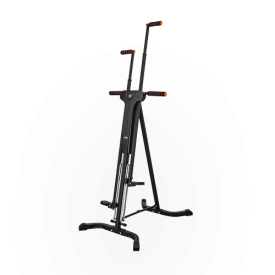
Relife Rebuild Your Life Vertical Climber
This compact vertical climber can fold up to a footprint measuring 3.13 square feet, which can be ideal for storage needs. Plus, the five available height adjustments can be excellent for creating a comfortable setup for athletes anywhere from 5’9” to 7’1”.
Specs
- Price: $399.99
- Max User Height: 7’1”
- Weight Capacity: 250lbs
- Resistance Levels: N/A
- Product Dimensions: 37.5” L x 28” W x 85” H
Pros
- This vertical climber folds inward to a footprint of 3.13 square feet for convenient storage.
- The height can be adjusted to suit athletes between 5’9” and 7’1”.
- The 43-pound frame can be easy to transport from room to room.
Cons
- The foam grips can be difficult to grasp during sweaty workouts, according to our tester.
- There are no true resistance levels, as the difficulty is related to your height settings.
- Some may prefer a more tech-driven center console.
Vertical climbers can be great for athletes tight on space thanks to their smaller footprint than other cardio machines. That said, having a profile that can be stored easily when not in use can be useful when trying to make the most of your training area. The Relife Rebuild Your Life Vertical Climber folds easily for tucked-away keepings, taking up just 3.13 square feet of flooring when stored.
When in operation, the footprint expands to 7.25 square feet, which is still compact enough for most spaces. Plus, we also appreciate how lightweight this machine is at just 43 pounds, which allows you to tote and transport the climber from room to room without much strain.
Our tester also noted how accommodating this vertical climber is when taking your height into consideration. The setup can be adjusted to suit athletes from 5’9” all the way up to 7’1”. According to the brand, these height adjustments can also change the intensity of your training session, but it may be best to match your height to these toggles more often than not.
The Relife Rebuild Your Life Vertical Climber also features a simplified display unit capable of tracking your time, step count, calories burned, and fat burned. It’s not the most involved console in this round-up, but we appreciate the inclusion as it provides some data-tracking capabilities.
Finally, our tester said that this vertical climber had a good sense of sturdiness to it while in use, which they attributed to the A-frame design of the legs. They did note, though, that the high-density foam across the handles can become slippery during sweat-riddled training sessions. So, it may be best to have a workout towel handy to help you maintain a worthwhile grip.
Best Vertical Climber for Beginners: MaxiClimber Vertical Climber
MaxiClimber Vertical Climber
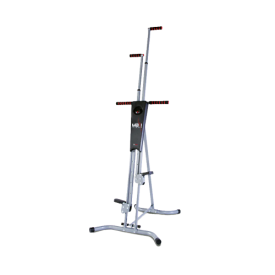
MaxiClimber Vertical Climber
This simple, compact vertical climber can be a great budget-friendly option for full-body training. The MaxiClimber classic also folds up neatly to just 3.02 square feet, which can be ideal for storing your equipment in less spacious environments.
Specs
- Price: $299.00
- Max User Height: 6’2”
- Weight Capacity: 240lbs
- Resistance Levels: Depends on your body weight
- Product Dimensions: 35.82” L x 28.3” W x 86.52” H
Pros
- The intuitive range of motion, simple console, and lightweight design make it ideal for beginner athletes.
- The vertical climber comes partially assembled for an easier build out of the box.
- The sub-$300 price tag is more affordable than other vertical climbers in this round-up.
Cons
- This climber can only support athletes under 6’2” or those weighing less than 240 pounds.
- Athletes with larger feet may prefer a larger pedal or one featuring a top strap for added security.
- There’s no device holder for streaming your workouts or programs.
Want to refresh your cardio but haven’t had a ton of experience with vertical climbers? The MaxiClimber Classic can be an excellent place to start. For one, this simple machine costs less than $300, so the initial investment is lower than other climbers you’ll find out there. Additionally, this vertical climber weighs just 33 pounds and can fold up to 3.02 square feet, allowing for convenient storage and easier portability around your house.
Our tester also noted how simple it was to get this machine up and running once it arrived at their home. The MaxiClimber Classic comes partially assembled, so there are fewer headaches when it comes to unboxing your equipment before your first workout.
The MaxiClimber Classic can also be a great pick for beginners because of how intuitive it is in operation. There are no resistance settings to dial in before training, so you’re working against your body weight during steps. The integrated display also tracks just two stats — steps completed and potential calories burned — which can make for easier tracking when in the throes of a workout.
The simple design of this vertical climber does have its limits, though. The frame can only support athletes under 240 pounds, as well as those under 6’2” in height. This means that larger or taller athletes may need a more durable, taller machine to accommodate worthwhile workouts. Our tester also stated that the foot pedals are somewhat small, which could be troublesome for those with larger feet. Anyone wearing a men’s size 12 and above may be left wanting more support underfoot.
Additionally, while we enjoy the simplified display, we do wish there was an added device holder to support streaming capabilities. Setting this machine up in front of your television for mid-training viewing is a breeze given its lightweight profile, sure, but a media shelf would be a nice touch. Still, for those just dipping their toes into vertical climbers, this is a fantastic profile to consider.
Best Advanced Vertical Climber: Rogue Versaclimber SM Sport Model
Rogue Versaclimber SM Sport Model
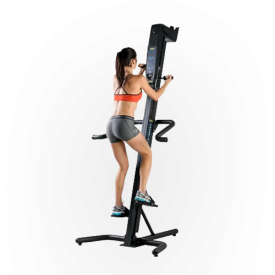
Rogue Versaclimber SM Sport Model
As one of the original climbing machines, this impressive rig can provide loads of training potential across its tension range up to 500 pounds. Additionally, there are 15 built-in modules designed to push your workouts to new heights … literally.
Specs
- Price: $4,995.00
- Max User Height: N/A
- Weight Capacity: 350lbs
- Resistance Levels: Up to 500lbs
- Product Dimensions: 46″ L x 43″ W x 94” H
Pros
- The 500-pound tension control is ideal for advanced athletes looking for a more challenging workout.
- This vertical climber can be mounted to the wall for added stability.
- This climber comes with six racing and nine distance programs built into the console.
Cons
- Those wanting a freestanding model will need to pay an extra $700.
- The 94-inch height may be too tall for some spaces.
- This is one of the most expensive vertical climbers we’ve encountered.
For advanced athletes wanting the best of the best, this foundational vertical climber can be the perfect fit. Versaclimbers are some of the original climbing machines, and this SM model comes equipped with plenty of features to help you get the most out of your daily ascents.
In testing, we appreciated how versatile this machine was thanks to its one-pound to 500-pound tension control range. This allowed us to really mix up our training intensities day in and day out. Additionally, our tester liked the 15 included workout programs — six racing modules and nine distance-centric sessions.
The adjustment capabilities also add to the versatility of the Versaclimber SM Sport. Arm travel can be toggled between one and 20 inches, which can be ideal for creating that comfortable fitment. The grips are also adjustable for varied setups like neutral grip, overhand grip, and underhand grip, giving you extra opportunities to engage your upper body throughout a workout.
The Versaclimber SM Sport is wall-mounted, which can be great for adding some stability to your setup. Freestanding models are also available, albeit for an extra $700. Whether you buy the freestanding add-on or not, this vertical climber is durable enough to support athletes up to 350 pounds across its steel framing.
We do recommend paying extra attention to your ceiling height with this vertical climber, though. Sitting at 94 inches tall, that’s right at the cusp of an eight-foot ceiling. If you want some extra room at the top of your reps to accommodate your knuckles, you may need more clearance.
Best Vertical Climber with Resistance: CLMBR Connected 02
CLMBR Connected 02
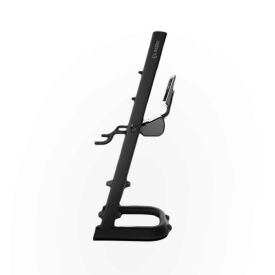
CLMBR Connected 02
The CLMBR Connected 02 features adjustable handles for alternating grip positions, as well as a sturdy frame capable of holding up to 350 pounds. Additionally, there’s plenty of tech strewn across the profile, including an integrated app delivering on-demand classes, challenges, guides, and more.
Specs
- Price: $3,995.00
- Max User Height: 7’
- Weight Capacity: 350lbs
- Resistance Levels: 11
- Product Dimensions: 35” L x 32” W x 88” H
Pros
- The machine’s 11 resistance levels are ideal for mixing up intensities.
- The integrated companion app can be great for varying up your training with instructor-led classes and challenges.
- Our tester noted that the machine felt very stable while in use.
Cons
- The subscription service is $39 monthly, which may be too much for some.
- Our tester said the assembly instructions were very complicated and required multiple people.
- The one-year warranty may leave some skeptical of this machine’s durability.
Training against resistance can be great for your physical health, as studies show that resistance training can lead to reduced body fat, increased muscular strength, boosted cardio demands, and more. (4) With 11 available resistance levels to choose from, the CLMBR Connected 02 is our favorite vertical climber for people wanting more strenuous, challenging workouts.
We enjoy the ergonomics of this well-built machine, which offers adjustable handles for neutral, overhand, and underhand grip positions during training. Our tester also said that the foot pedals feature a top strap for added security, similar to what you’d find across your favorite rowing machine. They did note, though, that athletes with larger feet (think men’s size 12 and above) may dwarf the footprint of each pedal, so some setup adjustments may need to occur before hopping on for a session.
The CLMBR Connected 02 is also capable of streaming instructor-led fitness classes through the brand’s companion app. The 21.5-inch HD touchscreen provides a clear picture for following along mid-workout, and the app boasts a plethora of classes, challenges, and guides to keep every workout engaging and entertaining.
The one major drawback when it comes to this resistance-ready vertical climber, though, lies in its assembly instructions. According to our tester, the instruction manual is very difficult to follow, and the complicated alignments required for proper setup definitely require a helping hand or two. For this reason, we highly recommend opting for a white glove delivery and installation, which the brand offers for $300.
Best Vertical Climber for Streaming: ProForm Carbon HIIT H10
ProForm Carbon HIIT H10
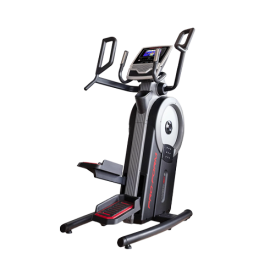
ProForm Carbon HIIT H10
This impressive ProForm climber-elliptical hybrid allows for vertical and horizontal movement in each stride, which help keep workouts comfortable and less impactful on your joints. Plus, the 24 available resistance levels allow for a good bit of intensity variety, so no training session is identical.
Specs
- Price: $1,403
- Max User Height: N/A
- Weight Capacity: 325lbs
- Resistance Levels: 24
- Product Dimensions: 52″ L x 29.25″ W x 66.7″ H
Pros
- The 10-inch HD touchscreen allows you to follow along with your favorite iFit fitness classes.
- Our tester noted that the vertical and horizontal motion plane is comfortable and less impactful than other climbers.
- The 24 levels of resistance can be great for changing workout intensities.
Cons
- This machine weighs 225 pounds and can be difficult to move for some.
- The 10-inch HD touchscreen may be too small for athletes wanting a wider streaming view.
- The Carbon HIIT H10 does not fold up for more convenient storage.
If you’re looking to follow along with your favorite trainer-led climbing workouts, we recommend the ProForm Carbon HIIT H10. This quality machine boasts a 10-inch HD touchscreen that’s integrated with iFit’s streaming library of over 17,000 live and on-demand training classes. This can be great for keeping sessions engaging while also breaking up the repetitive climbing routine that otherwise would have you staring at the ceiling during your entire ascent.
In addition to its iFit capabilities, this vertical climber is also unique thanks to its horizontal and vertical planes of motion, which mimic the movement you’d experience atop an elliptical. According to our tester, these planes helped create a more fluid stepping motion with each stride, which was easier on their joints and feet than other climbers they used in training.
The ProForm Carbon HIIT H10 is also compact, taking up just 10.56 square feet of flooring and sitting just under six feet tall. Don’t let the smaller stature fool you, though. This machine weighs a whopping 225 pounds, which may be difficult to maneuver around your training space when looking to change up your layout. There are two wheels at the front for easier transport, but it may be best to have a helping hand at the ready if you want to move this equipment regularly.
Our tester also recommends some assistance when assembling this vertical climber. The instructions are 34 steps in total, and given the heavier weight of the machine itself, it can be helpful to have an extra set of hands during the build.
How We Chose the Best Vertical Climbers
Outside of price, there are a few key factors that separate one vertical climber from the next. As such, we looked at a handful of components when building out this round-up. Read below to see how we determined which machines climbed the rankings and which were best left on the cutting room floor.
Equipment Footprint
Vertical climbers are typically more compact than cardio machines, like treadmills or rowing machines. Still, though, their footprints can vary from brand to brand. We sought out vertical climbers in a range of sizes. Our guide includes footprints as small as 7.04 square feet, as well as larger machines that take up 13.74 square feet.
We also took into account how tall each vertical climber was, opting for machines that could fit conveniently within rooms showcasing a standard eight-foot ceiling height. (3) We included these measurements in our listed specs for added clarity.
Resistance Levels
Climbing can be an effective workout while training against your body weight alone, but upping the ante with added resistance can be excellent for facilitating higher caloric burn and strength-building potential. (4) We examined a variety of machines offering different levels of resistance and included a handful of each in this guide.
We found that most machines offering some form of resistance did come with a higher price tag, but many are willing to pay the extra coin for the sake of more training options. Bodyweight-reliant profiles can be excellent for keeping the vertical climbers lightweight and portable, but you’ll need to have a planned approach to your pace and training intensity if you want to vary your sessions from one to the next.
Height and Weight Capacities
Vertical climbers are a unique piece of equipment because you need to account for both your height and weight when searching for a worthwhile profile. This is due to the upward motion you have in a given rep — if your machine is too compact, you could feel confined and uncomfortable during your workout.
We looked for durable, sturdy builds capable of supporting a variety of body weights, with our top picks capable of accommodating between 240 and 350 pounds more often than not. Vertical climbers with a lower weight capacity sacrificed some accommodations but also proved to be the most portable profiles of the bunch. Sturdier frames can be great for larger athletes but may require permanent placement in your space with no convenient storage capabilities.
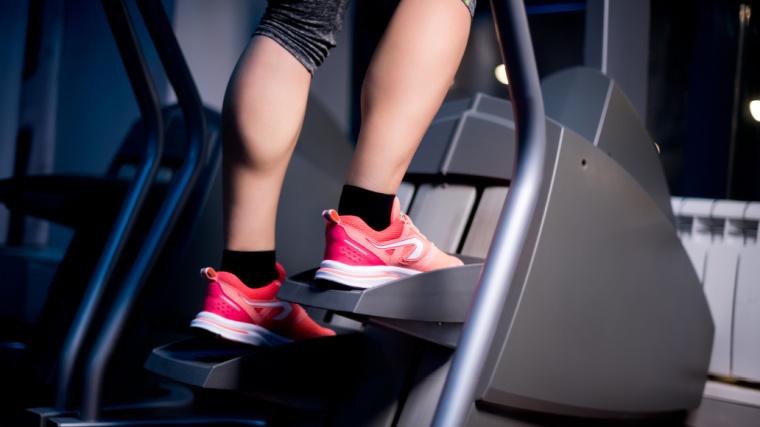
For height capacities, we found many of the top-performing vertical climbers were able to comfortably support athletes up to 7’1”. Adjustable frames were also a perk we looked for, as this gave us the ability to match our setups to our personal frames for the most comfortable alignment during training.
Portability
Given the increased height of vertical climbers, we don’t expect athletes to try and tote these machines from their homes to the gym and back each day. Still, having the ability to move your setup from room to room can be a nice perk, especially when trying to stream your workouts or favorite programs through a nearby television. We looked at a handful of lightweight, portable vertical climbers for this need, i.e., profiles weighing under 50 pounds for more manageable movement between spaces.
Portability also lends itself to storage, so we tried to find a handful of profiles capable of compact silhouettes when not in use. We measured the footprint of these machines when in operation as well as when stored, showcasing their space-saving capabilities as well. We found that machines taking up less than eight square feet of space fell perfectly into this “compact” bucket.
The Benefits of Vertical Climbers
Vertical climbers can be beneficial for a slew of athletes. Outside of their unique vertical plane of motion, these machines can be ideal for facilitating calorie-burning, full-body training sessions. Below are a handful of perks that can come with adding a vertical climber to your workout space.
Low-Impact Training
Studies show that low-impact training can be an effective form of physical activity with lower odds of injury. (5) This can be a result of the lower impact experienced across your joints and body during movement. Vertical climbers can be excellent options for athletes desiring a training regimen of this nature, as you’re not putting your joints, feet, and frame through a ton of strain in a given stride.
Like rowing machines or exercise bikes, you’re constantly in contact with the machine itself when operating a vertical climber. While you still hinge at your knees and elbows during a full step, the gravitational force you’d experience in, say, a stride atop a treadmill, is not present, which lessens the force you experience throughout a workout. This can be a huge benefit for a number of athletes, especially those dealing with nagging pain or musculoskeletal issues.
Higher Caloric Burn
According to Harvard Health, rock climbing can be an efficient physical discipline capable of high caloric burn, depending on your weight. (2) For example, a 185-pound athlete burns on average 335 calories while rock climbing for 30 minutes. Vertical climbing is virtually the same motion and discipline in a more controlled environment.
For reference, 185-pound athletes burn, on average, 294 calories during workouts atop a rowing machine or stationary bike at moderate paces. (2) Running atop a treadmill at a 12-mile-per-hour pace can burn up to 336 calories, but with the added impact felt across your joints. (2)
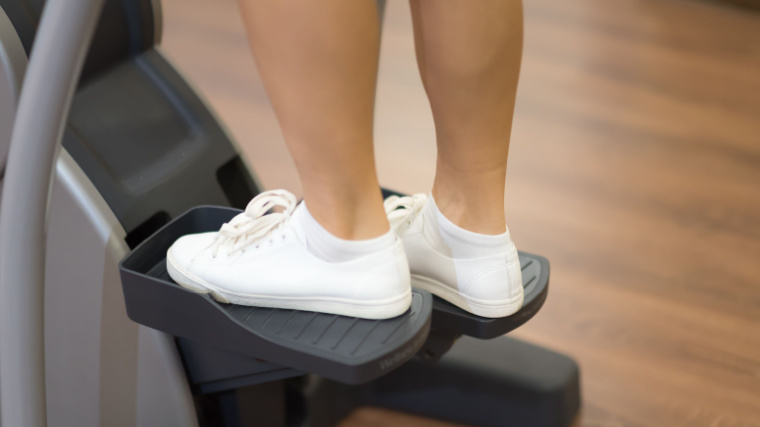
Vertical climbers facilitate higher caloric burns, given the fact that they engage both your upper and lower body in each rep. Combine that motion with (potential) added resistance, and you have a formulation for generating some sweat and progress.
Compact Silhouette
Vertical climbers are also more compact pieces of equipment than other cardio machines out there. This is due to the vertical plane of motion that sees you move your body upward rather than horizontally in a given rep. You don’t need a wide footprint to accommodate such a motion, leading to a more compact profile that can be ideal for athletes tight on training space.
That said, however, vertical climbers need ample clearance, so it’s always wise to measure your ceiling height before opting for this machine category.
What to Consider When Choosing the Best Vertical Climber
Adding a vertical climber to your training setup can be great for facilitating a full-body training experience. That said, you do need to account for how large your machine is, how portable it is, how expensive it is, and other factors before ultimately deciding on a singular profile.
Equipment Footprint
Thanks to their compact designs, vertical climbers can be beneficial for athletes with small workout spaces. Since you’re moving in a vertical plane rather than a horizontal one, you don’t need a lengthy track or belt to facilitate a worthwhile motion during training. Still, though, you want to ensure your machine fits your available space. Take some measurements prior to purchase to ensure your new machine doesn’t crowd your area with an excessive footprint.
Because of the vertical motion, these cardio machines will also be taller than your average home gym equipment. You want to make sure you have the proper clearance for your machine as well, so be sure to flip your tape measure upward during pre-purchase measurements, too. Typically, athletes with eight-foot ceilings should have enough overhead space to accommodate a vertical climber, but it doesn’t hurt to double-check.
Height and Weight Capacities
You’ll be putting your entire body weight across your vertical climber, so finding a profile that’s capable of supporting your frame during training is a must. Take a glance at the vertical climber’s weight capacity and compare it to your given weight. Ideally, you should have some space between the two metrics, as this can help alleviate any potential strain or unnecessary stress across your machine. Typically, vertical climbers can support anywhere from 240 to 350 pounds.
You should also consider your vertical climber’s height capacity prior to purchase. After all, the motion calls for you to stretch your physique to its tallest capabilities, and having a confined setup could lead to discomfort and compromised form. If you are a taller athlete, it may be wise to opt for a vertical climber with available arm extensions. This can help extend the step range while also keeping the motion comfortable across your larger physique.
Resistance Levels
Having a vertical climber with a resistance system can be a nice benefit, especially if you’re trying to utilize the machine for strength-focused workouts. That said, we’ve had plenty of worthwhile ascents that work against our body weight alone, so the feature isn’t absolutely needed for quality training. Be sure to take your fitness goals into consideration when deciding how much resistance you require in a vertical climber.
It should be noted, too, that vertical climbers without integrated resistance levels can often be cheaper than their challenge-ready counterparts. If you’re looking to save a little money on your home gym equipment, this can be a worthwhile tidbit to have on your mind.
Storage and Portability
If you want to train in multiple rooms across your floor plan, it helps to have a machine you can actually tote from space to space. Vertical climbers can come in an array of sizes — some heavier options will likely become permanent fixtures in a room, while others are lightweight enough for temporary setups. If you’d like to keep your training opportunities open to more than one area, consider opting for a lighter profile — around 50 pounds or less.
Some vertical climbers can also feature folding capabilities, which can be great for keeping your machine stowed away discreetly when not in use. Having a foldable vertical climber can also be ideal when trying to use your space as efficiently as possible — if you don’t need to stare at your fitness equipment in a living room or office, why would you?
Look closely at your wants and needs as they relate to how convenient you want your equipment to be. We’ve included both fixed and foldable vertical climbers in this round-up to help you decide on which profile is the perfect fit for your space.
Price
Like any piece of fitness equipment, you’ll want to ensure your machine fits within your budget before building out your vertical climbing workout plan. These profiles built for indoor ascents can range from $2999 to nearly $6,000, so there is a wide range of options. Additionally, some vertical climbers are integrated with online workout programs that will require an additional subscription, likely between $25 and $40 monthly.
Always be sure that your budget can support your training goals before adding any vertical climber to your cart. Yes, the benefits can help you take your training to new heights, but it’s much more difficult to crawl out of debt than it is to climb through a workout session.
Final Word
If you’re looking for a unique full-body workout experience that can combine cardio and strength in one, then we highly recommend vertical climbers. These impressive profiles can do wonders for your at-home regimen, all within a smaller footprint than your typical home gym machines like treadmills, ellipticals, rowing machines, and stationary bikes. Plus, studies indicate that climbing for 30 minutes can generate a higher caloric burn than other exercise modalities. (2)
When thinking about adding a vertical climber to your personal training space, make sure to consider how much clearance you have overhead, as well as your height and weight. These metrics can help you find worthwhile machines that not only fit your space but fit your physique as well. Use this guide as a roadmap for your search and get started on taking your training up a level (or three).
FAQs
Can you build muscle with a vertical climber?
Yes, vertical climbers can help you build muscle within your training. If you want to primarily use this machine as a strength-boosting discipline, it may be best to look for a profile featuring multiple resistance levels. Training against resistance has been shown to help support muscle growth along with reduced body fat, improved functional capacity, and other perks. (4)
What is the best vertical climber?
The best vertical climber is going to be different for every athlete, as multiple factors can influence which profile is perfect for your specific needs and wants. For our money, we recommend the ProForm Carbon HIIT H10 thanks to its iFit-enabled streaming capabilities, unique elliptical-climber hybrid makeup that creates forward and horizontal motion during workouts and its sturdy, secure frame that can support up to 325 pounds.
Are vertical climbers hard on your knees?
While any physical activity has the potential to cause joint discomfort, training with a vertical climber can lessen the impact felt across your knees than other disciplines. You aren’t lifting your legs off the ground in a given rep, and your body is constantly in contact with the machine itself. This can help facilitate a workout setup that less taxing on your joints, which can lead to fewer injuries and instances of discomfort. (5)
What is the weight limit for a vertical climber?
The weight capacity of a vertical climber can vary from brand to brand. The profiles included in this round-up range in limits from 240 to 350 pounds. When deciding on a vertical climber for your training regimen, make sure your machine’s weight capacity aligns with your body weight.
References
- BRAHLER, C. J., & BLANK, S. E. (1995). Versaclimbing elicits higher VO2max than does treadmill running or rowing ergometry. Medicine & Science in Sports & Exercise, 27(2).
- Calories burned in 30 minutes of leisure and routine activities. Harvard Health. (2021, March 8). https://www.health.harvard.edu/diet-and-weight-loss/calories-burned-in-30-minutes-for-people-of-three-different-weights
- Rybczynski, W. (n.d.). Ceiling Heights in Homes and Offices. Ceiling Heights in homes and offices – Zell/Lurie Real Estate Center. https://realestate.wharton.upenn.edu/working-papers/ceiling-heights-in-homes-and-offices/
- Kraemer, W. J., Ratamess, N. A., & French, D. N. (2002, June). Resistance training for Health and Performance. Current sports medicine reports. https://pubmed.ncbi.nlm.nih.gov/12831709/
- Tse, A. C., Wong, T. W., & Lee, P. H. (2015). Effect of low-intensity exercise on physical and cognitive health in older adults: A systematic review. Sports Medicine – Open, 1(1).
The post The 8 Best Vertical Climbers of 2023 appeared first on BarBend.

